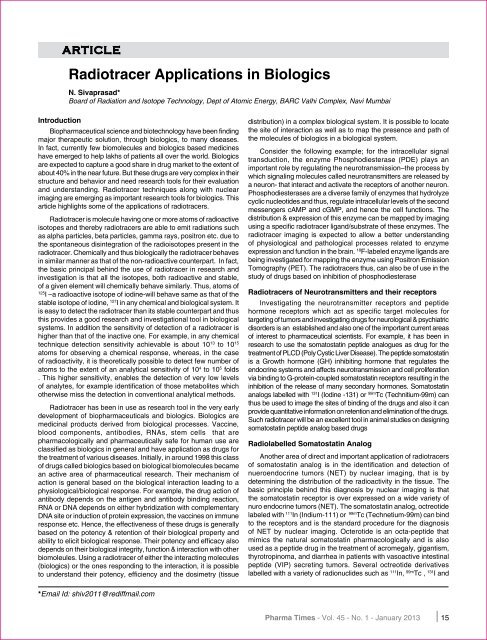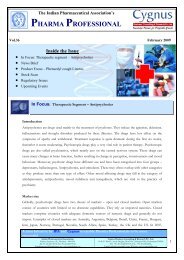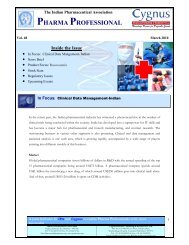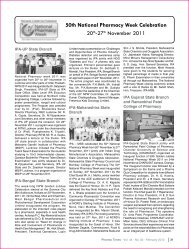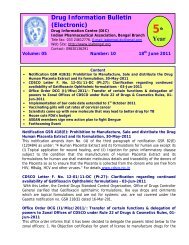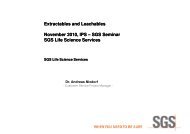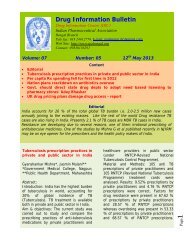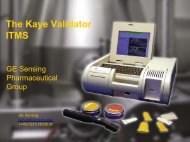Radiotracer Applications in Biologics - Indian Pharmaceutical ...
Radiotracer Applications in Biologics - Indian Pharmaceutical ...
Radiotracer Applications in Biologics - Indian Pharmaceutical ...
You also want an ePaper? Increase the reach of your titles
YUMPU automatically turns print PDFs into web optimized ePapers that Google loves.
Article<br />
<strong>Radiotracer</strong> <strong>Applications</strong> <strong>in</strong> <strong>Biologics</strong><br />
N. Sivaprasad*<br />
Board of Radiation and Isotope Technology, Dept of Atomic Energy, BARC Valhi Complex, Navi Mumbai<br />
Introduction<br />
Biopharmaceutical science and biotechnology have been f<strong>in</strong>d<strong>in</strong>g<br />
major therapeutic solution, through biologics, to many diseases.<br />
In fact, currently few biomolecules and biologics based medic<strong>in</strong>es<br />
have emerged to help lakhs of patients all over the world. <strong>Biologics</strong><br />
are expected to capture a good share <strong>in</strong> drug market to the extent of<br />
about 40% <strong>in</strong> the near future. But these drugs are very complex <strong>in</strong> their<br />
structure and behavior and need research tools for their evaluation<br />
and understand<strong>in</strong>g. <strong>Radiotracer</strong> techniques along with nuclear<br />
imag<strong>in</strong>g are emerg<strong>in</strong>g as important research tools for biologics. This<br />
article highlights some of the applications of radiotracers.<br />
<strong>Radiotracer</strong> is molecule hav<strong>in</strong>g one or more atoms of radioactive<br />
isotopes and thereby radiotracers are able to emit radiations such<br />
as alpha particles, beta particles, gamma rays, positron etc. due to<br />
the spontaneous dis<strong>in</strong>tegration of the radioisotopes present <strong>in</strong> the<br />
radiotracer. Chemically and thus biologically the radiotracer behaves<br />
<strong>in</strong> similar manner as that of the non-radioactive counterpart. In fact,<br />
the basic pr<strong>in</strong>cipal beh<strong>in</strong>d the use of radiotracer <strong>in</strong> research and<br />
<strong>in</strong>vestigation is that all the isotopes, both radioactive and stable,<br />
of a given element will chemically behave similarly. Thus, atoms of<br />
125<br />
I –a radioactive isotope of iod<strong>in</strong>e-will behave same as that of the<br />
stable isotope of iod<strong>in</strong>e, 127 I <strong>in</strong> any chemical and biological system. It<br />
is easy to detect the radiotracer than its stable counterpart and thus<br />
this provides a good research and <strong>in</strong>vestigational tool <strong>in</strong> biological<br />
systems. In addition the sensitivity of detection of a radiotracer is<br />
higher than that of the <strong>in</strong>active one. For example, <strong>in</strong> any chemical<br />
technique detection sensitivity achievable is about 10 13 to 10 15<br />
atoms for observ<strong>in</strong>g a chemical response, whereas, <strong>in</strong> the case<br />
of radioactivity, it is theoretically possible to detect few number of<br />
atoms to the extent of an analytical sensitivity of 10 4 to 10 5 folds<br />
. This higher sensitivity, enables the detection of very low levels<br />
of analytes, for example identification of those metabolites which<br />
otherwise miss the detection <strong>in</strong> conventional analytical methods.<br />
<strong>Radiotracer</strong> has been <strong>in</strong> use as research tool <strong>in</strong> the very early<br />
development of biopharmaceuticals and biologics. <strong>Biologics</strong> are<br />
medic<strong>in</strong>al products derived from biological processes. Vacc<strong>in</strong>e,<br />
blood components, antibodies, RNAs, stem cells that are<br />
pharmacologically and pharmaceutically safe for human use are<br />
classified as biologics <strong>in</strong> general and have application as drugs for<br />
the treatment of various diseases. Initially, <strong>in</strong> around 1998 this class<br />
of drugs called biologics based on biological biomolecules became<br />
an active area of pharmaceutical research. Their mechanism of<br />
action is general based on the biological <strong>in</strong>teraction lead<strong>in</strong>g to a<br />
physiological/biological response. For example, the drug action of<br />
antibody depends on the antigen and antibody b<strong>in</strong>d<strong>in</strong>g reaction,<br />
RNA or DNA depends on either hybridization with complementary<br />
DNA site or <strong>in</strong>duction of prote<strong>in</strong> expression, the vacc<strong>in</strong>es on immune<br />
response etc. Hence, the effectiveness of these drugs is generally<br />
based on the potency & retention of their biological property and<br />
ability to elicit biological response. Their potency and efficacy also<br />
depends on their biological <strong>in</strong>tegrity, function & <strong>in</strong>teraction with other<br />
biomoleules. Us<strong>in</strong>g a radiotracer of either the <strong>in</strong>teract<strong>in</strong>g molecules<br />
(biologics) or the ones respond<strong>in</strong>g to the <strong>in</strong>teraction, it is possible<br />
to understand their potency, efficiency and the dosimetry (tissue<br />
distribution) <strong>in</strong> a complex biological system. It is possible to locate<br />
the site of <strong>in</strong>teraction as well as to map the presence and path of<br />
the molecules of biologics <strong>in</strong> a biological system.<br />
Consider the follow<strong>in</strong>g example; for the <strong>in</strong>tracellular signal<br />
transduction, the enzyme Phosphodiesterase (PDE) plays an<br />
important role by regulat<strong>in</strong>g the neurotransmission–the process by<br />
which signal<strong>in</strong>g molecules called neurotransmitters are released by<br />
a neuron- that <strong>in</strong>teract and activate the receptors of another neuron.<br />
Phosphodiesterases are a diverse family of enzymes that hydrolyze<br />
cyclic nucleotides and thus, regulate <strong>in</strong>tracellular levels of the second<br />
messengers cAMP and cGMP, and hence the cell functions. The<br />
distribution & expression of this enzyme can be mapped by imag<strong>in</strong>g<br />
us<strong>in</strong>g a specific radiotracer ligand/substrate of these enzymes. The<br />
radiotracer imag<strong>in</strong>g is expected to allow a better understand<strong>in</strong>g<br />
of physiological and pathological processes related to enzyme<br />
expression and function <strong>in</strong> the bra<strong>in</strong>. 18 F-labeled enzyme ligands are<br />
be<strong>in</strong>g <strong>in</strong>vestigated for mapp<strong>in</strong>g the enzyme us<strong>in</strong>g Positron Emission<br />
Tomography (PET). The radiotracers thus, can also be of use <strong>in</strong> the<br />
study of drugs based on <strong>in</strong>hibition of phosphodiesterase<br />
<strong>Radiotracer</strong>s of Neurotransmitters and their receptors<br />
Investigat<strong>in</strong>g the neurotransmitter receptors and peptide<br />
hormone receptors which act as specific target molecules for<br />
target<strong>in</strong>g of tumors and <strong>in</strong>vestigat<strong>in</strong>g drugs for neurological & psychiatric<br />
disorders is an established and also one of the important current areas<br />
of <strong>in</strong>terest to pharmaceutical scientists. For example, it has been <strong>in</strong><br />
research to use the somatostat<strong>in</strong> peptide analogues as drug for the<br />
treatment of PLCD (Poly Cystic Liver Disease). The peptide somatostat<strong>in</strong><br />
is a Growth hormone (GH) <strong>in</strong>hibit<strong>in</strong>g hormone that regulates the<br />
endocr<strong>in</strong>e systems and affects neurotransmission and cell proliferation<br />
via b<strong>in</strong>d<strong>in</strong>g to G-prote<strong>in</strong>-coupled somatostat<strong>in</strong> receptors result<strong>in</strong>g <strong>in</strong> the<br />
<strong>in</strong>hibition of the release of many secondary hormones. Somatostat<strong>in</strong><br />
analogs labelled with 131 I (Iod<strong>in</strong>e -131) or 99m Tc (Technitium-99m) can<br />
thus be used to image the sites of b<strong>in</strong>d<strong>in</strong>g of the drugs and also it can<br />
provide quantitative <strong>in</strong>formation on retention and elim<strong>in</strong>ation of the drugs.<br />
Such radiotracer will be an excellent tool <strong>in</strong> animal studies on design<strong>in</strong>g<br />
somatostat<strong>in</strong> peptide analog based drugs<br />
Radiolabelled Somatostat<strong>in</strong> Analog<br />
Another area of direct and important application of radiotracers<br />
of somatostat<strong>in</strong> analog is <strong>in</strong> the identification and detection of<br />
nueroendocr<strong>in</strong>e tumors (NET) by nuclear imag<strong>in</strong>g, that is by<br />
determ<strong>in</strong><strong>in</strong>g the distribution of the radioactivity <strong>in</strong> the tissue. The<br />
basic pr<strong>in</strong>ciple beh<strong>in</strong>d this diagnosis by nuclear imag<strong>in</strong>g is that<br />
the somatostat<strong>in</strong> receptor is over expressed on a wide variety of<br />
nuro endocr<strong>in</strong>e tumors (NET). The somatostat<strong>in</strong> analog, octreotide<br />
labeled with 111 In (Indium-111) or 99m Tc (Technetium-99m) can b<strong>in</strong>d<br />
to the receptors and is the standard procedure for the diagnosis<br />
of NET by nuclear imag<strong>in</strong>g. Octerotide is an octa-peptide that<br />
mimics the natural somatostat<strong>in</strong> pharmacologically and is also<br />
used as a peptide drug <strong>in</strong> the treatment of acromegaly, gigantism,<br />
thyrotrop<strong>in</strong>oma, and diarrhea <strong>in</strong> patients with vasoactive <strong>in</strong>test<strong>in</strong>al<br />
peptide (VIP) secret<strong>in</strong>g tumors. Several octreotide derivatives<br />
labelled with a variety of radionuclides such as 111 In, 99m Tc , 131 I and<br />
*Email Id: shiv2011@rediffmail.com<br />
Pharma Times - Vol. 45 - No. 1 - January 2013 15
90<br />
Y(Ytterbium-90) have been successfully used for imag<strong>in</strong>g and<br />
also for radiotherapy of NET. The major benefit of peptides that<br />
are chemically tagged with a radio metal such as 90 Y, 99m Tc or 111 In<br />
is the build–up of the radio-metal-complex <strong>in</strong> the target cells. Thus<br />
this enables the specific detection of tumor site and their metastasis<br />
as well as delivery of radiation at the tumor site enabl<strong>in</strong>g the<br />
treatment. When the peptide carry<strong>in</strong>g radio metal is <strong>in</strong>ternalized, the<br />
radiolabelled metabolites are trapped <strong>in</strong> the lysosome and they can<br />
be identified. As mentioned earlier, labelled ocreotide peptide can<br />
hence be a research tool <strong>in</strong> the development of receptor based drugs<br />
and biologics for NET. Another important example of neurotransmitter<br />
receptor target<strong>in</strong>g is based on the use of dopam<strong>in</strong>e receptor.<br />
Radioisotope tagged dopam<strong>in</strong>e derivatives are commonly used to<br />
target tissue that over express the dopam<strong>in</strong>e receptor. These tracers<br />
are cl<strong>in</strong>ically used to diagnose dementia and some extent Park<strong>in</strong>son’s<br />
disease (PD). The tracers are also used to study dementia and drug<br />
addiction. The radiotracer study can be used to correlate to the degree<br />
of dementia – a support<strong>in</strong>g aid for the quantitation of the efficacy of<br />
the drug and biologics for dementia treatment<br />
Peptide & prote<strong>in</strong> based radiotracers<br />
Other than somatostat<strong>in</strong> analogs and neurotransmitters, there<br />
are many peptide based radiotracers are be<strong>in</strong>g studied for nuclear<br />
medic<strong>in</strong>e and imag<strong>in</strong>g applications. These are pharmaceutical<br />
formulations of radiotracers of peptides. Peptide based radiotracers<br />
are potential imag<strong>in</strong>g agents for understand<strong>in</strong>g bra<strong>in</strong> disorders,<br />
should these agents be enabled to undergo transport through the<br />
blood-bra<strong>in</strong> barrier (BBB) <strong>in</strong> vivo. Radiolabeled Amyloid beta–prote<strong>in</strong><br />
is a radiotracer of prote<strong>in</strong> based biologics to image and detects bra<strong>in</strong><br />
amyloid <strong>in</strong> tissue sections of Alzheimer’s diseased autopsy bra<strong>in</strong>. The<br />
13I<br />
I labelled prote<strong>in</strong> degrades <strong>in</strong> bra<strong>in</strong> with release of radioiod<strong>in</strong>e 131 I.<br />
Radiolabelled amyloid-beta peptide (Abeta) has been shown to label<br />
neuritic plaques (extracellular deposits of amyloid <strong>in</strong> the gray matter<br />
of the bra<strong>in</strong> and the deposits are associated with degenerative neural<br />
structures) <strong>in</strong> vitro, therefore it could provide a detection tool, if it also<br />
labels neuritic plaques <strong>in</strong> vivo follow<strong>in</strong>g <strong>in</strong>travenous <strong>in</strong>jection. It has<br />
also been shown that the Abeta possess permeability at the bloodbra<strong>in</strong><br />
barrier. In conclusion, these studies describe a methodology for<br />
evaluation of BBB drug delivery and target<strong>in</strong>g of peptides <strong>in</strong> bra<strong>in</strong>.<br />
Radiotrace for cell proliferation studies.<br />
For <strong>in</strong>-vitro <strong>in</strong>vestigation studies of drugs and biologics, cell<br />
culture technique is one of methods, where the determ<strong>in</strong>ation of<br />
viability and cell proliferation is required. For <strong>in</strong>vestigation of cancer<br />
drugs test<strong>in</strong>g <strong>in</strong> cancer cell culture and studies on cell proliferation is<br />
an established <strong>in</strong>-vitro procedure. One of the most familiar and widely<br />
used methods for quantify<strong>in</strong>g cell proliferation is the measurement of<br />
tritiated thymid<strong>in</strong>e ([ 3 H]-thymid<strong>in</strong>e) <strong>in</strong>corporation. Cells <strong>in</strong>corporate the<br />
radiolabeled DNA precursors <strong>in</strong>to newly synthesized DNA, such that<br />
the amount of <strong>in</strong>corporation, measured by liquid sc<strong>in</strong>tillation count<strong>in</strong>g,<br />
is a relative measure of cellular proliferation.<br />
Endothalial cell proliferation has been studied by radioligandreceptor<br />
b<strong>in</strong>d<strong>in</strong>g. The pr<strong>in</strong>cipal is that the ligands that b<strong>in</strong>d to sigma<br />
receptors can modulate the proliferation of the endothelial cells,<br />
which can then control the angiogenesis. Thus, these receptors<br />
have become a potential target for application <strong>in</strong> oncology. Other<br />
areas of <strong>in</strong>terest for <strong>in</strong>vestigation are cardiovascular and endocr<strong>in</strong>e<br />
system disorders. Some of the steroids such as progesterone,<br />
testosterone and dehydroepiandrosterone (DHEA), <strong>in</strong>teract with<br />
sigma-1 receptors. Radiolabelled steroids with 99m Tc or 131 I can then<br />
be of help for development of receptor ligand analog.<br />
Radioligands for sigma receptor<br />
Sigma receptors have also a role <strong>in</strong> manifestation of certa<strong>in</strong><br />
Alzheimer’s related disease. The precise biological functions<br />
of sigma receptors have not been well established. Recent<br />
<strong>in</strong>vestigation us<strong>in</strong>g radiotracers of the receptor b<strong>in</strong>d<strong>in</strong>g ligands has<br />
shown that Sigma receptor has the potential of be<strong>in</strong>g a target for<br />
development of biologics related to psychiatric and neurological<br />
disorders. Sigma receptors are classified <strong>in</strong>to sigma (1) and sigma<br />
(2) subtypes. There are attempts <strong>in</strong> the development of radiotracer<br />
for imag<strong>in</strong>g sigma -2 receptors so as to have a research probe.<br />
This approach is based on the experimental evidence that the<br />
sigma-2 receptors are expressed <strong>in</strong> high density <strong>in</strong> a number of<br />
human tumors, <strong>in</strong>clud<strong>in</strong>g breast tumors. Prelim<strong>in</strong>ary data so far<br />
obta<strong>in</strong>ed <strong>in</strong>dicates that radioiod<strong>in</strong>e labeled sigma-2 receptor b<strong>in</strong>d<strong>in</strong>g<br />
radiotracers can not only be used <strong>in</strong> the anatomical imag<strong>in</strong>g of<br />
breast tumors, but may also provide <strong>in</strong>formation regard<strong>in</strong>g the<br />
proliferative status of the breast cancer. Any biologics or drugs that<br />
is designed for <strong>in</strong>hibit<strong>in</strong>g the proliferation of the cells as a measure of<br />
<strong>in</strong>hibit<strong>in</strong>g the growth of the tumor can be <strong>in</strong>vestigated by estimat<strong>in</strong>g<br />
their effect of the drug on the proliferation of the cells us<strong>in</strong>g such<br />
radiotracer both by <strong>in</strong>-vivo as well as <strong>in</strong>-vitro procedures. For this<br />
and other reasons, sigma-1 receptors have been proposed as a l<strong>in</strong>k<br />
between the central nervous system and the endocr<strong>in</strong>e & reproductive<br />
system. This is largely an important, but an unexplored area. Thus, a<br />
promis<strong>in</strong>g area of research is to exam<strong>in</strong>e the biological function and<br />
therapeutic potential of sigma receptors which can be achieved through<br />
radiotracers. Subtype of sigma receptor has dist<strong>in</strong>ct physiological and<br />
pharmacological profile <strong>in</strong> the central and peripheral nervous system.<br />
The characterization of these subtypes and the discovery of new<br />
specific sigma receptor ligands through radiotracer demonstrated that<br />
sigma receptors are targets for the development of suitable biologics<br />
for treatment of neuropsychiatric diseases such as schizophrenia and<br />
depression. Furthermore, consider<strong>in</strong>g the potential of sigma receptor<br />
<strong>in</strong>vestigation, imag<strong>in</strong>g of sigma (1) receptors <strong>in</strong> bra<strong>in</strong> us<strong>in</strong>g specific<br />
PET radio labelled ligands have been <strong>in</strong>itiated recently.<br />
P-glycoprote<strong>in</strong><br />
P-glycoprote<strong>in</strong> (P-gp) is associated with cell membrane. P-gp<br />
is a well-characterized transporter prote<strong>in</strong>. This prote<strong>in</strong> is encoded<br />
by multidrug resistant gene (MDR1). P-gp transports number<br />
of molecules across extra- and <strong>in</strong>tra-cellular membranes. This<br />
prote<strong>in</strong> pays a role <strong>in</strong> the removal of drugs from the <strong>in</strong>tracellular<br />
compartment of the cells. Thus this causes a decrease <strong>in</strong> drug<br />
build-up <strong>in</strong> drug-resistant cells and often mediates the development<br />
of resistance for drugs for cancer treatment. In the case of BBB<br />
this prote<strong>in</strong> also functions as a transporter. The radiotracers of<br />
high specificity and aff<strong>in</strong>ity <strong>in</strong>hibitors of P-gp are shown to be a<br />
good biologic marker to assess the expression and distribution<br />
of this transporter. Radioactive [ 11 C]-verapamil has been used<br />
for measur<strong>in</strong>g P-glycoprote<strong>in</strong> function with positron emission<br />
tomography (PET). Verapmil is an L-type calcium channel blocker of<br />
the phenyl alkylam<strong>in</strong>e class. Under conditions where the expression<br />
of P-gp is <strong>in</strong>creased, the <strong>in</strong>tensity of PET signal also correspond<strong>in</strong>gly<br />
<strong>in</strong>creases. At the same time, the uptake of substrates of the<br />
transporter decreases. Studies on b<strong>in</strong>d<strong>in</strong>g of other radiotracers such<br />
as [ 11 C] laniquidar with PET can also be of use for assess<strong>in</strong>g P-gp<br />
expression. Laniquidar is an <strong>in</strong>hibitor of P-gp. The technique and<br />
application of PET is described elsewhere <strong>in</strong> this article.<br />
Stem cells<br />
Stem cell is cellular biologics. Animal studies and cl<strong>in</strong>ical trials<br />
have shown that there is a potential with stem cell based therapy<br />
particularly for the cardiovascular diseases. Stem cells are now<br />
attempted to treat conditions such as leukemia and have the potential<br />
to treat many more diseases and disorders where patient survival is<br />
reliant on organ and tissue donation. Stem cell research and its cl<strong>in</strong>ical<br />
applications are expected to make the stem cell a regular biological<br />
drug for therapy <strong>in</strong> future. The cardiovascular stem cell based therapies<br />
have been established fairly beyond doubt. <strong>Radiotracer</strong> can also play<br />
a role <strong>in</strong> the determ<strong>in</strong>ation of the fate of stem cell non-<strong>in</strong>vasively <strong>in</strong> a<br />
biological system. The most important <strong>in</strong> the stem cell therapy is the<br />
Pharma Times - Vol. 45 - No. 1 - January 2013 16
evaluation of the implanted cells. Currently, it is difficult to establish<br />
whether stem cells have survived follow<strong>in</strong>g transplantation <strong>in</strong> the body<br />
and if they reach their target site or migrate elsewhere. <strong>Radiotracer</strong><br />
based PET and SPECT (S<strong>in</strong>gle Photon Computed Tomography) are<br />
recommended to be one of the effective means to track the cell l<strong>in</strong>es.<br />
The radiotracer for this study can either be done by direct label<strong>in</strong>g of<br />
the stem cells or through reporter gene. In the direct methodology, the<br />
stem cells are radiolabelled and followed for few hours. The cell label<strong>in</strong>g<br />
methods are well established. White blood cells are labelled us<strong>in</strong>g the<br />
labell<strong>in</strong>g agent [ 99m Tc] hexamethyl propylene am<strong>in</strong>e oxime (HMPAO) for<br />
imag<strong>in</strong>g <strong>in</strong>flammation site. Similar method can be adopted for labell<strong>in</strong>g<br />
stem cells. The labell<strong>in</strong>g <strong>in</strong>volves a short <strong>in</strong>cubation with the labell<strong>in</strong>g<br />
agents and subsequent purification. Whereas, <strong>in</strong> the second method,<br />
the stem cells are transfected with reporter gene and the expression<br />
is imaged by a suitable radio substrate that can b<strong>in</strong>d to the gene<br />
expressed molecules, thereby the assessment of cell survival and<br />
proliferation can be monitored non-<strong>in</strong>versely and externally.<br />
PET Imag<strong>in</strong>g<br />
Nuclear Imag<strong>in</strong>g is an excellent tool for understand<strong>in</strong>g the tissue<br />
distribution of biologics and their movement <strong>in</strong> a liv<strong>in</strong>g system non<strong>in</strong>versely.<br />
The biomolecules under <strong>in</strong>vestigation can be radiolabelled<br />
with either gamma emitt<strong>in</strong>g or positron emitt<strong>in</strong>g radioisotope to<br />
prepare a radiotracer. The radiotracer is adm<strong>in</strong>istered to human<br />
or animal <strong>in</strong>ternally, for example <strong>in</strong>travenously or orally. Then,<br />
external detectors (Gamma or PET camera) capture the radiation<br />
and form images from the radiation emitted by the radiotracer.<br />
This process is unlike a diagnostic X-ray where external radiation<br />
is passed through the body to form an image. PET and SPECT<br />
are techniques used for this purpose. PET uses positron emitt<strong>in</strong>g<br />
radiotracer. In the case of positron emitters the positron undergoes<br />
annihilation with electrons and gamma rays are generated which<br />
are detected by PET camera and constructs the images. SPECT<br />
uses gamma emitt<strong>in</strong>g radiotracers.<br />
PET and SPECT based nuclear imag<strong>in</strong>g can detect the<br />
radionuclide tagged to biologics which <strong>in</strong>teract with biochemical<br />
process <strong>in</strong> liv<strong>in</strong>g subjects. This imag<strong>in</strong>g modality is very sensitive to<br />
the extent of 10 -11 moles of radiotracer, this sensitivity enables PET and<br />
SPECT to detect the biological process <strong>in</strong> a very low levels. Because<br />
of the sensitivity this imag<strong>in</strong>g techniques can offer, the radiotracer that<br />
needs to be adm<strong>in</strong>istered is also very small, that it does not alter the<br />
biological equilibrium of the biochemical reactions and pathways. PET<br />
and SPECT though <strong>in</strong>itially developed for imag<strong>in</strong>g <strong>in</strong> human, now the<br />
technology offers imag<strong>in</strong>g <strong>in</strong> small animals enabl<strong>in</strong>g to carry out the<br />
studies <strong>in</strong> small animals such as mice, rat etc. The special imag<strong>in</strong>g<br />
resolution can also be as slow as 3-2 mm.<br />
In fact human <strong>in</strong> vivo nuclear imag<strong>in</strong>g by PET brought a new<br />
concept <strong>in</strong> pharmacology, and it can answer many questions<br />
related to drug development. Biodistribution studies with biological<br />
molecules carry<strong>in</strong>g positron-emitt<strong>in</strong>g radioisotopes can test whether<br />
a bioactive molecule reaches a target tissue compartment (such<br />
as bra<strong>in</strong>) <strong>in</strong> adequate amounts so as to effect the pharmacological<br />
activity. Comb<strong>in</strong>ed application of PET and Magnetic Resonance<br />
Imag<strong>in</strong>g (MRI) modality allows the understand<strong>in</strong>g of the relation of<br />
molecular <strong>in</strong>teractions with anatomical or physiological changes<br />
<strong>in</strong> tissue. Recently the drug researchers are of the op<strong>in</strong>ion that<br />
the potential value of nuclear imag<strong>in</strong>g should be considered at<br />
the earliest stages of development of drugs as PET allows the<br />
determ<strong>in</strong>ation of the effect of a biologics on patients’ metabolic<br />
parameters. In addition, PET may be used to follow the fate of a<br />
compound <strong>in</strong> vivo, allow<strong>in</strong>g visualization of its b<strong>in</strong>d<strong>in</strong>g to specific<br />
receptors and a direct study of the mechanism of drug action <strong>in</strong><br />
normal and pathological situations.<br />
Structural <strong>in</strong>formation is considered to be essential for<br />
determ<strong>in</strong><strong>in</strong>g the prote<strong>in</strong> b<strong>in</strong>d<strong>in</strong>g with molecules <strong>in</strong> the target<br />
tissues. Currently the focus is screen<strong>in</strong>g of the multiple biologic<br />
target and rational design of high-aff<strong>in</strong>ity peptide phamachore for<br />
the development of biologics us<strong>in</strong>g large throughput assays. This<br />
type of approach is required for characteriz<strong>in</strong>g the large number of<br />
prote<strong>in</strong>s currently be<strong>in</strong>g generated by structural genomics research.<br />
<strong>Radiotracer</strong> based PET can play a significant role <strong>in</strong> development of<br />
such biologics. In cl<strong>in</strong>ical trials, it is possible to test whether it reta<strong>in</strong>s<br />
the biological potential, whether the biologic molecules reached the<br />
target tissue. If so what would be the effective quantity available<br />
at the target site etc. A radiolabelled biologic with 11 C or 18 F and<br />
with the aid of PET can throw light on these questions. Another<br />
area of application of PET is b<strong>in</strong>d<strong>in</strong>g studies with a radiolabelled<br />
analog of the bioactive moiety of biologics that b<strong>in</strong>ds to the target<br />
of therapeutic <strong>in</strong>terest with adequate specificity and aff<strong>in</strong>ity. This<br />
will enable direct assessment of the relationship between biologics<br />
blood concentration and target occupancy. Such radiotracers can<br />
be of use <strong>in</strong> quantitat<strong>in</strong>g relative rates of biological processes,<br />
which is useful pharmacodynamic <strong>in</strong>formation. Apart from this PET<br />
and SPECT can detect and quantitate physiological processes<br />
— such as tumor activity, bra<strong>in</strong> function etc. The nuclear imag<strong>in</strong>g<br />
us<strong>in</strong>g radiolabelled pharamcore of the biologics can thus, reveal<br />
the pathophysiology of disease; tumor metabolism and tumorassociated<br />
angiogenesis provided the radiolabelled biomolecule<br />
entity is stable <strong>in</strong> physiological conditions.<br />
Quantitative whole-body autoradiography (QWBA)<br />
QWBA is an <strong>in</strong>-vivo radiotracer technique carried out <strong>in</strong><br />
animals and dissected human tissue, which has evolved as one<br />
of the important radiotracer studies <strong>in</strong> drug development. Whole<br />
body autoradiography produces an image of the distribution of a<br />
radioactively labelled test drug and biologics over the entire animal<br />
body sections. After adm<strong>in</strong>istration of radiolabelled tracer the<br />
animal is euthanized and snap frozen. Frozen sections are cut and<br />
radioactivity distribution is imaged. Radioactivity levels <strong>in</strong> <strong>in</strong>dividual<br />
structures are quantified and results are expressed as amount of<br />
drug equivalent per unit mass of tissue. In these studies, 14 C or 125 I<br />
labeled drugs and biologics are commonly employed for the study<br />
of tissue distribution and pharmacok<strong>in</strong>etics. Furthermore, the use of<br />
radiolabelled standards and digital image process<strong>in</strong>g can give more<br />
accurate qualitative and quantitative analysis <strong>in</strong> whole-body sections.<br />
QWBA is the preferred method for tissue distribution studies required<br />
for regulatory fil<strong>in</strong>g of a new drug entity and for project<strong>in</strong>g tissue<br />
dosimetry <strong>in</strong> human mass balance studies. This commonly used for<br />
drugs is very well applicable for biologics also.<br />
Conclusion<br />
When it comes to biologics str<strong>in</strong>gent evaluation and characterization<br />
is very important and essential. For example str<strong>in</strong>gent purity and<br />
cl<strong>in</strong>ical safety requirements are established by regulatory authorities.<br />
Also the cost of development of new biologics has been phenomenal<br />
and concerted efforts are necessary to address cost reductions.<br />
The use of radiolabelled biomolecules and related techniques has<br />
recently shown great promise as has been demonstrated by various<br />
researchers. Due to the noteworthy impact of radiotracer based<br />
studies and nuclear imag<strong>in</strong>g <strong>in</strong> development of biologics and drugs,<br />
cl<strong>in</strong>ical evaluation studies can be now performed earlier than that <strong>in</strong><br />
the past. <strong>Radiotracer</strong> techniques and nuclear imag<strong>in</strong>g will def<strong>in</strong>itely<br />
benefit the research <strong>in</strong> the development of biologics<br />
Further Read<strong>in</strong>g<br />
1. Jayachandran, N, Unny V. K. P, Sivaprasad N.<br />
2. Radiolabelled compounds production Program <strong>in</strong> India.<br />
3. Proc. N<strong>in</strong>th Int. Symp. on Synthesis and <strong>Applications</strong> of Isotopically<br />
Labelled Compounds’, Ed<strong>in</strong>burgh, 16-20 July, 2006.<br />
4. The World Health Organization (WHO)<br />
5. Use of Ioniz<strong>in</strong>g Radiation and Radionuclide on Human Be<strong>in</strong>gs for<br />
Medical Research, Tra<strong>in</strong><strong>in</strong>g and Non-medical Purposes,<br />
6. WHO Technical Report Series 611, Geneva: WHO, 1977<br />
7. Graham Lapp<strong>in</strong> & Simon Temple (Editors)<br />
8. ‘<strong>Radiotracer</strong>s <strong>in</strong> Drug Development’<br />
9. CRC Press; 1 edition (2006)<br />
Pharma Times - Vol. 45 - No. 1 - January 2013 17


